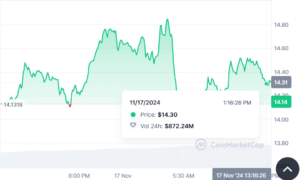Highlights:
- Chainlink’s CRE framework helps traditional finance connect smoothly with blockchain technology.
- CRE replaces outdated systems like COBOL, enabling easier blockchain integration for financial institutions.
- Chainlink’s privacy tools and partnerships make blockchain adoption secure and accessible for businesses.
Chainlink has unveiled the Chainlink Runtime Environment (CRE). The platform aims to enhance the compatibility of blockchain with conventional financial models. The CRE offers a standardized environment through which financial institutions can interface effectively with the blockchain networks.
🔗 Chainlink introduces the Chainlink Runtime Environment, a unified framework to connect traditional finance (like COBOL-based ATMs) with blockchain and smart contracts. 🚀
Chainlink is also working with SWIFT and UBS to tokenize fund settlements without needing crypto! 🏦📈…
— Crypto With Telo (@CryptowithTelo) November 17, 2024
Businesses have been relying on technologies like the COBOL and Java Runtime Environment (JRE) to drive their financial systems. These systems were very important in shaping concepts such as ATMs and online banking systems. However, these technologies are now outdated. They are not well equipped to meet modern applications of blockchain technology.
CRE solves this challenge by implementing a new structure that is compatible with blockchain technology. It provides a layered system that can be incorporated into the existing business model without having to revamp the entire system.
CRE’s Role in Bridging Traditional Systems and Blockchain
CRE integrates the roles of a conventional financial institution with the application of blockchain technology. Financial institutions can maintain their existing systems while accessing the benefits of blockchain. The CRE makes it possible to handle blockchain data securely and efficiently.
For businesses, this means reduced operational risks and lower costs when integrating blockchain. Financial systems can now scale and innovate without having to abandon their established technologies.
Partnerships Boost Blockchain Adoption in Finance
Recently, Chainlink entered into a new partnership with SWIFT, which is one of the largest interbank messaging systems. This partnership will enable banks to send SWIFT messages to blockchain systems and vice versa, thus integrating traditional finance into decentralized finance (DeFi).
Swift Chainlink Partnership: A Game-Changer in Finance
The financial world is buzzing with the recent collaboration between Chainlink and Swift, a partnership that promises to reshape the landscape of financial transactions and data management. Here's why this alliance is… pic.twitter.com/Ek3xnG6a1q
— Jonathan Hall (@Bitcollector) November 9, 2024
SWIFT processes millions of transactions each day, and now, through this integration, the messaging system can engage with Blockchain technology. The integration allows the bank to take advantage of blockchain technology in financial operations like international transfers.
By partnering with these companies, Chainlink is establishing itself as a key player in the financial sector. It makes blockchain a familiar concept in conventional financial structures and helps establish confidence among financial ventures. This, in turn, will lead to even more businesses looking into the possibility of implementing the use of blockchain technology.
Enhancing Privacy and Growth of the Blockchain
Chainlink is also committed to privacy and security since it connects blockchain with traditional finance. Blockchain Privacy Manager lets organizations employ blockchain in their processes without compromising data privacy.
Another key feature is the Cross-Chain Interoperability Protocol which enables private transactions within several different chains. This helps to ensure that several companies can keep their data secure yet leverage on the advantages that arise from the decentralized technologies.
The introduction of the CRE framework has led to a surge in LINK’s price. LINK is currently priced at about $14.30, and its trading volume has increased by more than 38% in the past 24 hours.

Analysts predict that as more institutions adopt blockchain platforms such as CRE and more successful collaborations with organizations such as SWIFT occur, LINK may reach or exceed $20 by the end of 2025.





